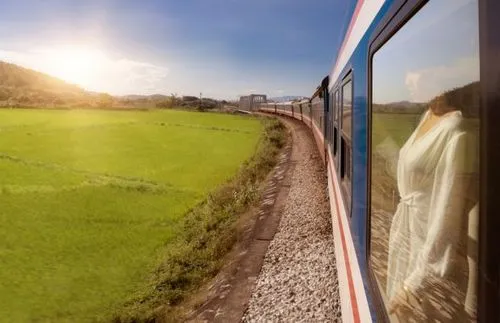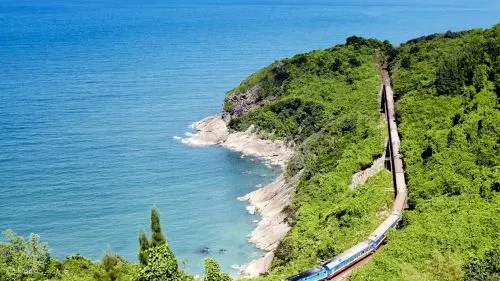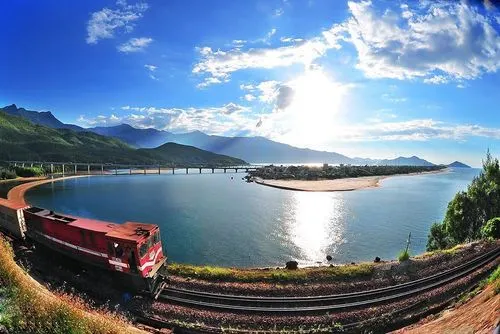Hai Van Pass Scenic Train Route: Overview and Highlights with Ovuigo
The Hai Van Pass train journey is Vietnam’s most spectacular railway experience, connecting Da Nang and Hue across the country’s dramatic central coastline. Spanning 21 kilometers between these two key cities, the route carves along lush mountainsides and overlooks the South China Sea. As the train climbs to elevations up to 496 meters, passengers navigate a blend of sea view tunnels 🕳️, mountain cliff tracks ⛰️, and sweeping panoramic vistas.
The Hai Van Pass is an iconic landmark in Southeast Asia’s railway system. Originally part of the French-built Indochina Rail history, the line remains a key connector in the Vietnam railway network, now operated by Vietnam Railways and served by the famous Reunification Express. Renowned travel sources often rank this as one of Asia’s top five scenic rail journeys, thanks to its stirring fusion of wilderness, history, and coastal beauty.
Beyond its natural charms, the Hai Van Pass played historic roles during wartime and forms a vital link in the Trans-Vietnam railway. Its unique features—like steep coastal switchbacks and views over Lang Co Bay—make it favored by travelers who wish to avoid the busy road journey or flying. For those keen to move from road journey 🚗 and highway 🛣️ travel, riding this train is the best way to immerse in central Vietnamese landscapes and culture.
– Map: View Hai Van Pass on Google Maps

Train Schedule and Travel Duration Between Da Nang and Hue
Trains run daily along the Da Nang to Hue route, providing multiple departures that cater to different itineraries. Vietnam Railways operates a series of trains, including SE1, SE2, SE3, SE4, SE5, SE6, SE7, and SE8—the most popular for tourism is often the mid-morning or early afternoon departure for optimal daylight scenic views. On average, the train covers the Da Nang Station map to Hue Station map distance in approximately 2.5 hours.
Best times for this journey are outside the rainy season (September–December) when skies are clear, enhancing the mountain and sea views. Travelers can choose between hard seat, soft seat, and sleeper berths—most opt for soft seat for daylight comfort. Pricing varies (3–10, or 70,000–240,000 VND) depending on class and time of booking, with soft seats typically around 120,000–170,000 VND. Check up-to-date train schedules with Vietnam Railways or reputable ticketing partners like ovuigo for the highest reliability.
Travel tip: Book tickets with Ovuigo for daylight hours for the best panoramic views 🏞️ and photo opportunities, and sit on the left-hand side when traveling from Da Nang to Hue for optimal coastline vistas.

Booking Hai Van Pass Train Tickets: Prices and How-To Guide
To book Hai Van Pass train tickets, travelers have two main options: online booking or in-person at the station. For online bookings, use the official Vietnam Railways website or trusted platforms like ovuigo. Search for the Da Nang–Hue section, select your preferred date and class, and follow the secure payment process. Confirmation is usually instant, with digital tickets or vouchers sent via email.
At the stations—Da Nang Railway Station (791 Hải Phòng, Thanh Khê District) and Hue Railway Station (Nguyễn Tri Phương Street)—ticket counters are open daily. Bring your passport/ID and allow at least 30 minutes before departure to account for queues, especially during weekends or holiday periods.
Ticket Prices (2024):
- Hard seat: 70,000–100,000 VND (~3–4)
- Soft seat: 120,000–170,000 VND (~5–7)
- Sleeper berth: 180,000–240,000 VND (~8–10)
Accessibility: Trains are generally wheelchair friendly and offer restrooms in each carriage. Comfort on Vietnamese trains rivals the region’s best, with air-conditioning and large windows 🍃.
Essential documents are a valid passport (for foreign travelers) and your booking reference. For peace of mind, aim to book at least 48 hours ahead, especially in high season. Families and groups can often choose adjacent seats. For up-to-date ticketing and travel concern support, call +84868319161 (via Whatsapp).
Remember: We don’t run tours — we craft experiences. Each journey is a story written just for you, designed for those who wish to explore Vietnam slowly, deeply, and meaningfully. No fixed itineraries. No crowds. Just you — and the moments that truly matter.

Scenic Views and Notable Stops Along the Hai Van Railway
The Hai Van Pass railway promises some of Vietnam’s most breathtaking landscapes. Shortly after departing Da Nang, passengers gaze onto the shimmering South China Sea and witness the dragon-shaped contours of the mountains 🐉. The train negotiates steep switchbacks, hugs the mountainside, and plunges into sea view tunnels—perfect for capturing shimmering panoramas and vivid holiday snaps.
Key highlights include:
- Lang Co Bay map: A turquoise lagoon flanked by white-sand beaches, visible as the train descends northward.
- Lang Co Beach: Easily spotted from your carriage, this celebrated beach marks the transition from steep cliffs to flat, idyllic coast.
- Hai Van Tunnel: The engineering jewel of the route; at 6.28 km, it’s the longest railway tunnel in Southeast Asia.
- Bach Ma National Park map: Dense forests and rare birdlife line the route near Bach Ma National Park. Keep your camera ready for glimpses of vibrant foliage and, with luck, wildlife.
- Historic French Watchtowers: At the pass’s highest point, spot ruins that stand as reminders of the area’s French colonial and military significance.
Insider tip: The section between Hai Van summit and Lang Co offers the clearest, uninterrupted views—have your camera ready. Watch for weather changes; mist and fog cover the peaks many mornings, lending a mystical air but sometimes minimizing visibility. If you’re a keen photographer, sit close to the window and be prepared as the train exits each tunnel for the most vivid scenes.

History and Engineering of the Hai Van Pass Railway
Constructed under French colonial rule, the Hai Van Pass segment stands as a prime example of early 20th-century rail engineering. Carved into the rugged mountainside, the line exemplifies resilience and technical prowess. Early operations faced challenges from steep grades, tropical weather, and wartime disruptions. Today’s tracks—part of the historic Trans-Vietnam railway—retain the original spirit but have benefitted from modern upgrades.
The route features a dramatic sequence of coastal switchbacks and the impressive Hai Van tunnel, ensuring safe passage through the highest elevations. Several bridges span deep valleys and ravines, while smaller tunnels punctuate the journey. The French built watchtowers and bunkers at the summit to secure the pass. Remnants of this defensive past remain, now adding historic depth to the stunning scenery 👷.
Hai Van Pass has survived as a working artery of the Vietnam railway network, outlasting conflicts and persistent natural challenges like landslides and fog. Today, it is both a symbol of Vietnam’s resilience and a treasured experience for anyone who values travel by train 🚆 over road journey or flying.

Travel Tips for Enjoying the Hai Van Pass Train Experience
Prepare for your scenic train ride Hai Van Pass with a few practical steps. Dress in lightweight, breathable fabrics, as carriages are air-conditioned but might warm up midday. Windows open in some coaches, so bring a light jacket or scarf in case of drafts.
If you’re sensitive to motion, choose a seat near the center of the carriage. For the best photographic opportunities along the mountain pass, select a left-side window seat leaving Da Nang, or right side from Hue. Seats fill quickly in peak months, so reserve early—especially around Tet (Lunar New Year).
Pack water, snacks, and a camera with a polarizing filter for vivid landscape shots. Binoculars are handy for birdwatching near Bach Ma National Park, and a travel journal can help you record the journey’s most memorable moments. For accessibility, contact rail staff—most trains are equipped for wheelchair users, and assistance is available at both Da Nang and Hue stations.
To avoid disappointment, travel outside typhoon season; March to August offers the most reliable weather, while fog-shrouded November–January journeys can be enchanting, albeit with risk of limited views. If your itinerary allows, pair the train ride with stops in either city: Da Nang for the Dragon Bridge or Marble Mountains, Hue for Thuan An Beach and its historic citadel.
For personalized guidance, book your Hai Van Pass railway tour via ovuigo, or contact us on Whatsapp: +84868319161. Remember, we don’t run tours — we craft experiences. Each journey is a story written just for you, designed for those who wish to explore Vietnam slowly, deeply, and meaningfully. No fixed itineraries. No crowds. Just you — and the moments that truly matter.
Experience the unforgettable and extend your Vietnamese rail adventure with unique stays such as The Manor Hoi An, Hola 1, and Hola 2.




